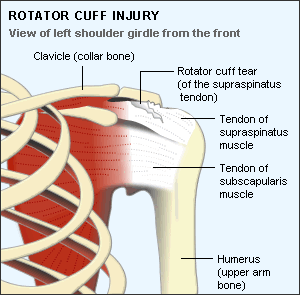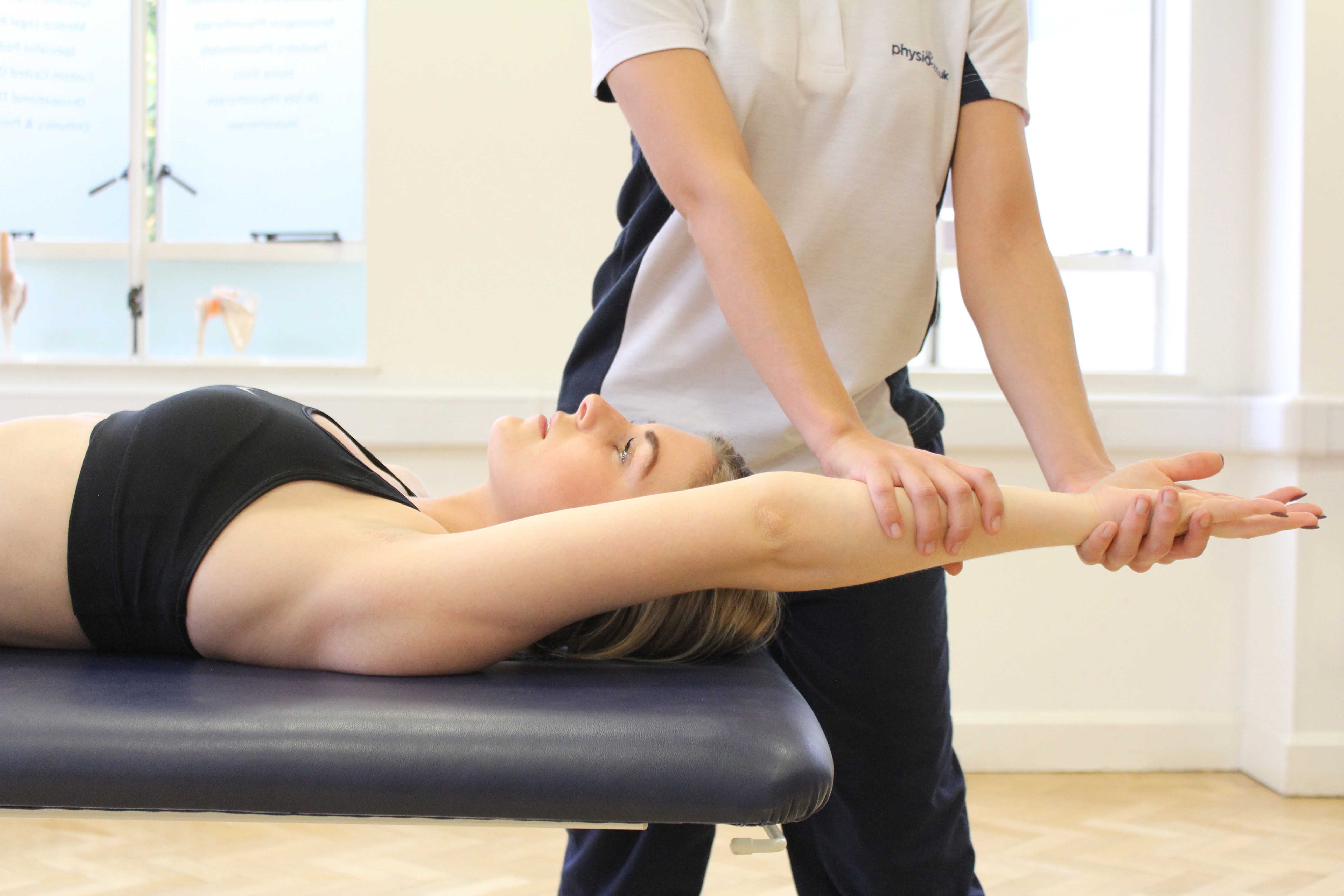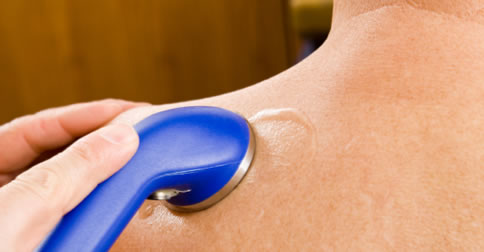nalco group
bone, muscle & joint pain physio
BOOK NOW / WHATSAPP ABOUT YOUR PAIN OR INJURY
- NOVENA 10 Sinaran Drive, Novena Medical Center #10-09, Singapore 307506
- TAMPINES 9 Tampines Grande #01-20 Singapore 528735
- SERANGOON 265 Serangoon Central Drive #04-269 Singapore 550265
Home > Blog > Physiotherapy > Conditions > Shoulder Pain > Left Shoulder Pain > Torn Rotator Cuff Physiotherapy Symptoms & Treatment
Torn Rotator Cuff Physiotherapy
Symptoms & Treatment

Patients who sustain a torn rotator cuff will experience symptoms such as
- pain across the shoulder
- arm weakness and
- difficulty with activities above or behind your head and back
Our rotator cuff muscles refer to a group of four specific muscles which control the movement and position of the shoulder. Any forms of damage to the rotator cuff tendons can happen
- through repetitive wear and tear or
- from an injury such as a fall on to an outstretched arm
Rotator cuff tears are actually a very very common cause of shoulder pain and are often associated with shoulder impingement syndrome.
Typically, this painful shoulder condition most commonly affect
- people over the age of forty
- sportsmen and
- construction workers
In this torn rotator cuff article, we will look at
- how our rotator cuff muscles works
- how they can get damaged
- what are the common torn rotator cuff symptoms
- what are the common diagnoses and
- rotator cuff injury treatment options
What is the Rotator Cuff?
The rotator cuff is a group of four muscles that work together to control and move the shoulder.
Our shoulder is made up of three bones:
- the humerus (arm bone)
- scapula (shoulder blade) and
- the clavicle (collar bone)
The shoulder joint, also known as the glenohumeral joint, is type of ball and socket joint. The round head of the humerus forms the "ball" which sits in the shallow socket formed by part of the scapula.
The rotator cuff muscles surround the joint holding the ball and socket together like a glove, and they connect the humerus to the shoulder blade.
Each rotator cuff muscle originates from the shoulder blade and forms into tendons which then inserts (attaches) on to the humerus.
Note that it is the rotator cuff tendons part that tends to get damaged.
The four muscles that make up the rotator cuff are:
- Supraspinatus across the top of the shoulder. Initiates abduction (moving the arm out sideways) and stabilises the shoulder during movement. It is the most commonly damaged rotator cuff tendon out of the 4 muscles.
- Infraspinatus at the back of the shoulder. Laterally rotates the arm (turns it outwards)
- Teres Minor at the back of the shoulder below infraspinatus. Laterally rotates the arm (turns it outwards)
- Subscapularis that runs across to the front of the shoulder. Medially rotates the arm (turns it inwards)
Causes of Rotator Cuff Tears
Torn rotator cuff symptoms can develop gradually over time through
wear and tear, known as a degenerative tear, or suddenly from an injury,
known as an acute tear.
1) Degenerative Tear
This is the most common cause of rotator cuff tears. As we age, the rotator cuff increasingly experiences wear and tear from a number of factors:
- Repetitive Friction: repetitive
activities which involve the rotator cuff will increase the strain on the rotator cuff
tendons.
Activities where the arm is frequently overhead such as sports with throwing motions or racket sports, occupations involving manual labour and general day-to-day activities above head-height particularly increase the strain on the rotator cuff making it prone to damage. - Bone Spurs: as we age, we can develop bone spurs, small outgrowths of bone which make our joints less smooth. These spurs can rub on the tendon, leading to fraying and gradual shearing and tearing of the tendon
Once we reach and cross over the age of around forty years of age, any damage to the tendons tends to become increasingly slow to heal as the blood flow and circulation isn’t as good as compared to when we are young.
That's why rotator cuff tears often never get a chance to heal properly and seem to just get progressively worse.
As a result, you are much more likely to experience torn rotator cuff symptoms over the age of forty.
Poor posture and poor ergonomics can also make you more prone to a degenerative rotator cuff tear.
One example of this is a forward rounded posture (known as
kyphosis), as it reduces the space in the shoulder joint and that causes and unnatural increase of pressure on the tendons.
2) Acute Injury
Torn rotator cuff symptoms can also develop suddenly after an injury. The two most common ways to damage the rotator cuff are:
- A Fall: landing on an outstretched arm
- Lifting: picking up something awkwardly that is too heavy
Younger patients more of the time develop a rotator cuff tear from an acute injury (falls, trauma, sports injuries) whereas degenerative rotator cuff tears and more common in those over the age of forty.
Torn Rotator Cuff Symptoms

With a degenerative torn rotator cuff, the symptoms tend to start of fairly mild and get progressively worse over time.
Conversely, suddenly and traumatic acute rotator cuff tears more typically cause instant, immediate and intense shoulder pain.
Torn rotator cuff symptoms commonly include:
1) Pain: across the shoulder, often described as a dull ache deep inside.
The pain tends to get worse when
- lifting or rotating your arm such as with activities such as
brushing your hair or
- when lying on that side in bed which often leads to disturbed sleep.
As the condition gets worse, you may experience
shoulder pain even when you're resting your affected or painful shoulder.
2) Weakness: difficulty lifting or twisting the arm, which can lead to decreased range of movement
3) Crepitus: you may notice unusual cracking or popping noises when you move the arm due to the decreased stability of the shoulder
Torn rotator cuff symptoms will depend on the severity of the injury.
There are three grades for tendon strains:
- Grade 1 Strain: overstretching of tendon, but no fibres are torn
- Grade 2 Strain: a partial rotator cuff tear – some of the fibres are torn
- Grade 3 Strain: a complete tear, known as a full thickness rotator cuff tear. The tendon has completely detached from the bone. In this case, you may lose the ability to abduct your arm (lift it to the side)
Diagnosing Rotator Cuff Tears

Your orthopedic doctor will start by
- taking your history
- finding out how and when
the pain started and
- finding out how the arm is feeling
to identify your diagnosis and if it's a torn rotator cuff symptoms.
He or she will then continue to examine the arm,
- looking at your range of movement and strength
- palpating the different structures
- moving your arm into different positions
He may well also examine your neck, as neck
problems often present with shoulder pain.
Depending on your torn rotator cuff symptoms, your shoulder doctor may send you for further investigations, such as
- x-rays, to look for any bone spurs or arthritis or
- MRI or ultrasound scan to look at the soft tissues and identify the presence, location and size of a tear.
conservative physiotherapy treatment
no injections or surgery
Treatment will depend on
- the severity of the injury,
- the
age of the patient and
- activity level of the patient
Treatment should target not "just" your torn rotator cuff symptoms, but the underlying core cause of the problem, such as
- any areas of weakness or
- postural issues and problems
In most
cases, conservative treatment (non-surgical) is sufficient, but in more
severe cases such as grade 3 tears, or if symptoms have failed to
settle, patient may need corrective shoulder rotator cuff surgery.

Conservative treatment usually involves a combination of the following:
1) Medication:
Your doctor may prescribe to you painkillers and/or anti-inflammatories to
reduce your torn rotator cuff tear symptoms of pain and swelling
2) Rest:
It is very important to avoid activities that cause and aggravates your shoulder pain, if not you may risk the rotator cuff tear to get worse.
With acute tears, you are likely to be given a sling to
wear initially...but at the same time, it is really important to balance rest and immobilization with keeping the arm moving
in a pain-free range, otherwise shoulder joint stiffness and shoulder weakness will set in
3) Exercises:
Our senior physiotherapists can work on a shoulder rehabilitation program with you to help you regain strength and movement in the shoulder as well as address any underlying issues such as poor posture from long term weakness and any shoulder joint tightness which may have caused or contributed to the shoulder tear in the first place.
We may also carry out deep transverse friction massage to help the
tendons heal correctly and/or acupuncture to help relieve pain. See more
below in item 5.
4) Steroid Injections:
In some cases, your doctor may recommend a steroid injection (H&L or K&L injection) to help reduce your torn rotator cuff symptoms. A mixture of local anaesthetic and corticosteroid is injected into the shoulder to help
- reduce pain and
- reduce inflammation
Note that every joint can get at most 2-3 of such injections over few years, or in some patients, over their lifetimes.

5) Shoulder Pain Physiotherapy, which will include treatments such as
- cold therapy
- heat therapy
- moist heat paraffin wax therapy
- radio-frequency Indiba physiotherapy to accelerate soft tissue healing
- joint mobilization
- stretching exercises
- strengthening exercises
- scar management
- hands on manipulation and mobilization (manual therapy)
- soft tissue management
- heat therapy and heat treatment and heat pack to relief tight muscles and joints
- ultrasound therapy to accelerate soft tissue healing
- exercise therapy
- acupuncture and/or dry needling
- deep tissue release
- and more
Unfortunately, there is no such things as a quick fix for torn rotator cuff symptoms. It can take a few months for your shoulder pain and torn rotator cuff symptoms and pains to settle down, so it is important to persevere with treatment.
